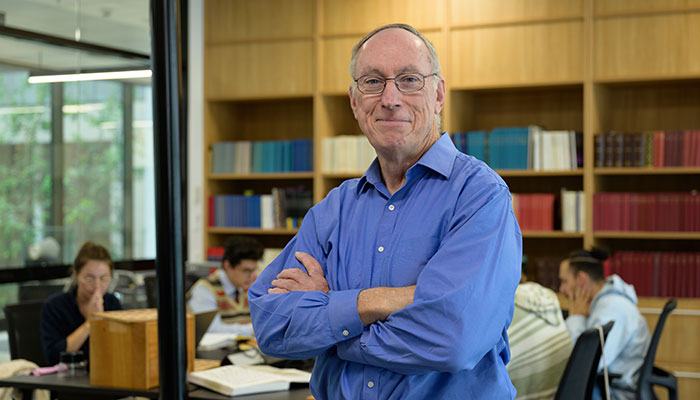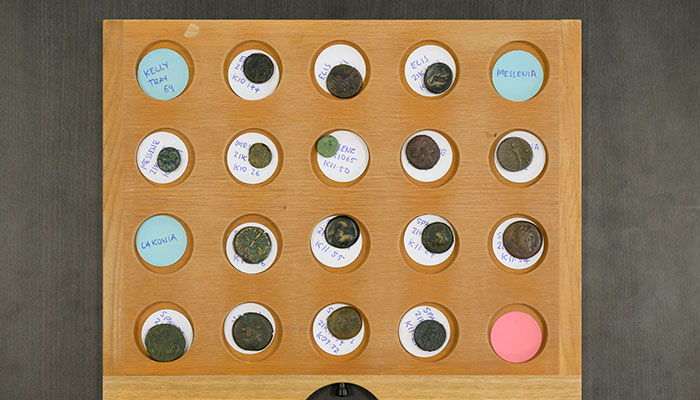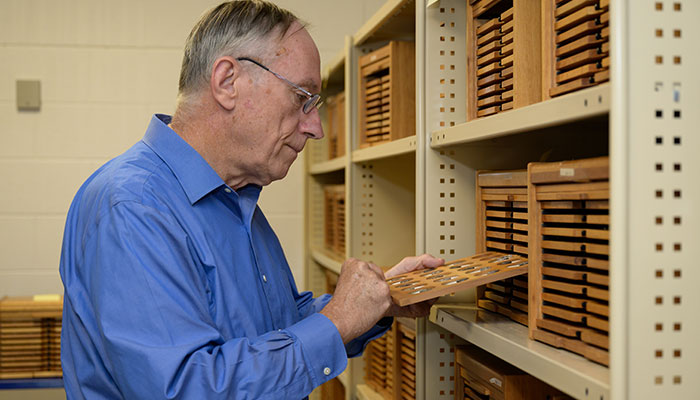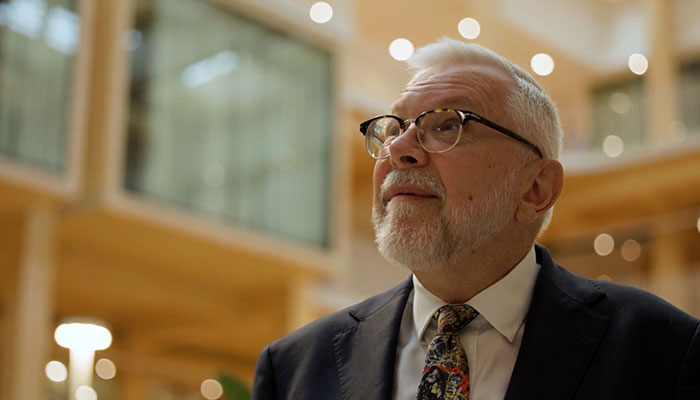Macquarie University has one of the largest collections of ancient coins in the Southern Hemisphere, with some 6500 specimens housed in a purpose-built research facility.

Unique opportunity: Under the guidance of Professor Ken Sheedy, pictured, students have access to a vast collection of ancient coins which provide important historical information.
The Australian Centre for Ancient Numismatic Studies (ACANS) is a recognised leader in the study of ancient coins, fostering a vibrant, interdisciplinary research network for students who can make use of a dedicated library, an extensive journal archive and a microscopy station.
Says Associate Professor Kenneth Sheedy, founding director of ACANS: “This is one of the few occasions in which we can actually give students hands-on access to really important artefacts from the ancient world, artefacts that convey important historical information.
“We’ve tried to make ACANS a leading university centre for the study of coins as a critical part of the highly depleted and very fragmentary assembly of objects that have survived from the ancient societies of the Mediterranean world.”
ACANS was established in 1999 with an endowment and, after he died in 2007, a donation from Dr William Gale (a lawyer turned student of ancient history at Macquarie University) and his wife, Janet Gale. The core collection of 2500 coins reflects Dr Gale’s special interest in three fields of Italian history: the Greek cities in South Italy, Republican Rome, and the Roman Emperor Hadrian. It also included important holdings dealing with Corinth and the portraiture of Roman emperors.
The Centre’s success has encouraged donations of both coins and funds. The entire ACANS collection now spans 10 centuries of coinage, 500 BC to about 500 AD.
Our students learn how to use one of the most sophisticated museum object management systems currently in use by museums around the world today.
So what can the humble ancient coin tell us?
Says Associate Professor Sheedy, “Coins, and especially hoards and combined site finds, can give you a good idea of economic activity in a city, especially in the marketplace. They can be an indicator of trade with other cities and even the presence of foreign traders using important trade routes.
“Coins can give you a sense of the relative prosperity of a city, the diversity of activity, and the economic reach of its industries.”

Stories unearthed: Coins such as those in the Kelly Collection, pictured above, give us a sense of the relative prosperity of a city and the economic reach of its industries, says Professor Sheedy.
For the past two years, undergraduate student volunteers and Professional and Community Engagement program (PACE) interns have been busy working at ACANS cataloguing an exciting new collection of more than 1,100 Greek and Roman coins.
The Kelly Collection was donated in 2021 by Dr Douglas Kelly, a keen collector and former lecturer in ancient history (with an intellectual soft spot for the Greek military leader and philosopher, Xenophon) at Macquarie University.
The value of the cataloguing is immeasurable. Once the coins have been meticulously described and photographed on the university collections management database (EMu), they can be made available via the university collections portal for use by students, teachers, researchers and the public.
Says Associate Professor Sheedy: “The students learn skills for the study of ancient numismatics. They develop a ‘hands-on’ knowledge of these silver and bronze objects and are able to analyse and describe the coins in detail.
“They learn how to research the coins in the publications of the leading museums (notably through reference to catalogues in the Sylloge Nummorum Graecorum series – to which ACANS has also contributed through its publication of the Gale collection of South Italian coinage).
“They also learn how to use one of the most sophisticated museum object management systems currently in use by museums around the world today. They acquire skills and experience in data entry that are a real advantage when they apply for positions in cultural institutions outside MQ.”
It’s also a reminder of just what coins are! Many young credit card-wielding students rarely use them. Society is using less cash. In 2020-21, the Royal Australian Mint in Canberra produced $82.2 billion worth of new coins, down from $114 billion a decade earlier. In the future, with the decline in circulating currency, the Mint will place greater emphasis on collectable and investment coins.
- Dreaming of overseas study? The world's your oyster at Macquarie
- Action! Film students get behind the camera asap
For now, Macquarie’s ancient coins keep the story of commerce alive. The collection housed by ACANS is one that Associate Professor Sheedy finds endlessly enthralling.

Masterpieces: Professor Sheedy says the Australian Centre for Ancient Numisimatic Studies is home to coins minted by Greeks in South Italy which are among the best of their kind in the world.
“We’ve got two small Cypriot gold coins, one of which is only the fourth known specimen of this issue in the world. This incredible rarity was minted by a little-known 4th century BC ruler of the Cypriot town of Salamis called Menelaus, the brother of Ptolemy I, who ruled Egypt," says Professor Sheedy.
“But what always takes my breath away is the importance and beauty of the Gale Collection of coins minted by Greek colonies in South Italy; it’s an unbelievably fine collection, one of the best of its kind in the world.”
Generally, he says, Australia is not strong on ancient Mediterranean art. “But in numismatics, we are really well served (in spades!). The artistic quality of the Gale Collection (from the Greek to the Roman coins) is right up there.
“Some of the coins here at ACANS are miniature masterpieces.”
Associate Professor Kennth Sheedy is Director of Numismatic Studies in the Department of History and Archaeology



